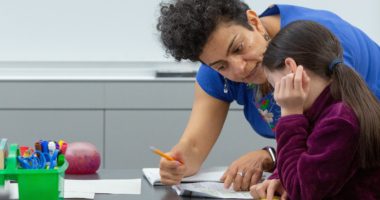A Tale of Two Seventh-Graders
The following story is adapted from our Equity in Motion convening, when Sonja Brookins Santelises — our outgoing vice president for K-12 policy and practice, who will become CEO of Baltimore Public Schools this summer — shared the starkly contrasting experiences of two students in Baltimore.
“The powerful play goes on, and you may contribute a verse.” — Walt Whitman
It was noon, early spring. Smack dab in the middle of the school day. The seventh-grader walked along the sidewalk in West Baltimore, empty backpack slung over a slumped shoulder, worn sneakers scuffing pavement as he moved in no particular direction.
We asked him why he wasn’t in school.
“I’m suspended,” he replied.
“Oh. Well, when do you get to go back?”
“I think maybe next week. I’m not really sure.”
We wondered if the educators in his school had any idea that their student, not yet even in his teens, was walking the streets through open air drug markets with nowhere else to go.
Or whether they knew what he knew even at his tender age, that those streets would accept him when his school would not.
It may have been his first suspension. Or his fifth. But what was certain was that his still-growing feet were on a road that had swallowed too many young people whose journeys astray from their schools and potential had started off this same way.
At the same hour, in another Baltimore neighborhood not so far away, another seventh-grader’s similarly sized feet were stepping onto the squeaky, freshly waxed stage in the school auditorium. He, the star in the school play.
A struggling student, he was more accustomed to the flickering fluorescent strip lighting in the back of the class than the spotlight that now shone down on him.
His interest had been awakened in seventh-grade English class, where he was assigned by his teacher to read a play. The twisting plot, punchy dialogue, vivid characters, and pulse-racing drama excited his imagination and ignited his curiosity and thirst for knowledge. He should try out for the school play, his teacher encouraged him.
He did, and was cast in the lead. He was lifted by high expectations and warm applause. He was transforming, seeing himself as he could be. As his teacher already saw him.
The seventh-grader walking the streets nearby at noon on a school day, suspended, was also transforming. Was also seeing himself as he could be. Perhaps as his teachers already saw him.
Less than a mile apart in geography and closer than that in experience, these two seventh-graders could have been the same kid. They could have been brothers. Fragile central figures in the early acts of their own plays. But their stories unfolded differently, one drawn into the warmth of their school in nurturing embrace, the other narrative expelled out onto the cold streets.
Educators lament about the powerful lure of the streets outside our schools. That lure is real, and we are not naïve to it. But, too often, educators forget about the even more powerful lure of engaging learning and opportunity inside their walls. The lure of chemistry experiments that inspire the next scientist, fierce political debates that spur the next president, rich literature that sets off the next poet laureate, complex equations that engross the next mathematician.
We cannot control the open air drug trade on the streets that some of our kids travel and play on. But we can surely help to control whether they are on those streets during the school day.
And we absolutely can control the experiences they have in the classroom. We can control what we do to draw them into school, to expand their minds with engaging learning, and to help them imagine a future for themselves beyond what they may see outside the school doors.
The stories of those two seventh-graders, and the hundreds of thousands of seventh-graders just like them, are unfolding in our schools at this very moment.
And we have the honor of contributing a verse.
What that verse will be is up to us.











